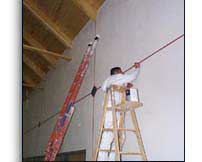

|
|

|
|
|
Types of Paint Most paints can be classified according to their vehicles or binders which are described below. Just click on a link below for more information.
Alkyds are extremely versatile synthetic resins that dry faster and are much harder than ordinary oils such as linseed oil. They are made by combining synthetic materials with various vegetable oils (linseed, soya, tung, etc.) to produce clear resins. Drying results from both the evaporation of the solvent and from oxidation of the alkyd. Mineral Spirits is used as the solvent and thinner for most alkyd paints.
Alkyd paints are generally available in a wide range of sheens for interior or exterior architectural and industrial plants. They have gradually replaced oil base paints because of their faster dry, and superior gloss and color retention. Like oil base paints, alkyds will tend to yellow or darken with age in interior environments, although not as severely. They should not be used directly on masonry or other alkaline surfaces such as plaster, galvanized metal or brick.
Latex Paints Latex paints have become extremely popular for painting both interior and exterior surfaces. Their advantages versus alkyd or oil paints include better color and gloss retention, VOC compliance, lower odor, faster dry and recoating, easier clean-up, more blister and peel resistance and better alkali resistance. The main limitations of latex paints are they should be applied above 50 F. and they must be kept from freezing. The two most common types of latex paints are:
Vinyl Acrylic Latex (PVA) - Used mostly in interior wall paints and trim enamels. Provides excellent washability, yellowing resistance, ease of applications and self-sealing properties. Fast dry allows applications of two coats in one day. Does not raise the "grain" of drywall fibers. Limitations are inferior wet adhesion, water resistance, alkali resistance and gloss and color retention versus acrylic latexes.
Epoxy Ester Coatings
They can be used on areas where there is some splash and spillage of chemicals. Epoxy esters are not as hard or chemical resistant as catalyzed epoxies, but offer a good compromise in performance between epoxies and alkyd paint. They will lose gloss and chalk in exterior areas, but only appearance not performance is affected.
Catalyzed Epoxy Coatings
Catalyzed epoxy coatings provide outstanding chemical resistance making them ideal for use in industrial areas. Commonly used as floor coatings due to their excellent abrasion resistance. Also used as glazed wall tile-like finishes due to their outstanding stain resistance, hardness and ease of cleaning. Most epoxies will tend to chalk rapidly on exterior surfaces and yellow in interior areas, but remain durable.
Polyurethane Finishes Oil-Modified Urethanes - This type consists of a blend of urethanes, drying oils and alkyds. They dry by evaporation of solvent and oxidation of the oil. They are one package, air dry types. They feature outstanding abrasion resistance on wood floors, furniture, paneling, cabinets, etc. |
Estimate Form |
Testimonials |
Contact Us |
Paint Guru |
About Us
Services |
Portfolio |
Our Commitment |
E-mail |
Home |
Links
|
Web site by Net-Time, Inc. The contents of this web site are the property of J.C. French. Copyright © J.C. French 1999-2003 |